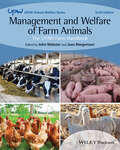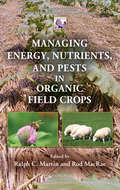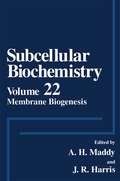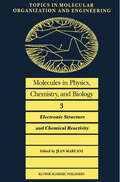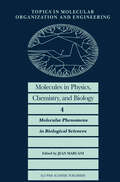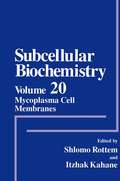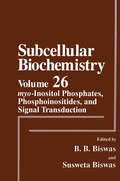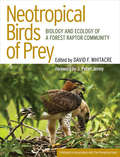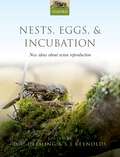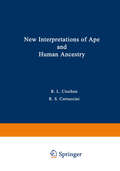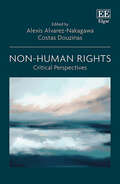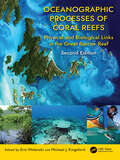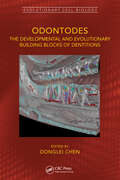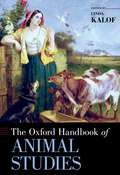- Table View
- List View
Management and Welfare of Farm Animals: The UFAW Farm Handbook (UFAW Animal Welfare)
Management and Welfare of Farm Animals provides comprehensive and up-to-date information on the humane management of all major farmed species in both large-scale food production and alternative farming systems. Designed for agricultural and veterinary science students, this classic textbook covers the management and welfare of species including dairy and beef cattle, veal calves, sheep, pigs, chickens, turkeys, goats, horses, and farmed fish. The sixth edition incorporates recent developments throughout, including an entirely new chapter on international developments in animal welfare law, politics, and practice. Updated chapters discuss topics such as 'high welfare' livestock systems, the impact of automation and new technologies on production and welfare, the ecological impact and sustainability issues of large-scale production systems, and more. Provides a basic understanding of the principles and practices of professional and humane farm animal management Covers animal husbandry, behavior as an indicator of animal welfare, and the assessment, monitoring, and promotion of improved welfare at the farm level Offers updated information on free-range poultry, robot milking, automated disease scanning, and pastoral systems in the developing world Includes less-common farm species such as South American camelids, ostriches, and game birds Management and Welfare of Farm Animals, Sixth Edition remains the ideal textbook for students in professional, technical, or vocational education courses on the management and welfare of farm animals.
Managing Energy, Nutrients, and Pests in Organic Field Crops
The use of organic management practices in field cropping continues to rise globally, and these methods have proven to be a viable way to produce food with reduced resource use and environmental damage. Managing Energy, Nutrients, and Pests in Organic Field Crops challenges the popular misconception that organic systems are weak at managing energy,
Meadow Pipit (Large Print)
This is an image of a Meadow Pipit shown from the side, with its head facing to the left of the page. There is a locator dot shown, which will be at the top left of the page when the image is the right way up. Its small sharp beak is open and one eye can be seen. Down the page from this is the Pipit's chest. To the right of this one wing is shown. Down again are its delicate legs. Its plumage is brown with lighter brown on its body. To the very right of the page is the Pipit's tail.
Meadow Pipit (UEB Contracted)
This is an image of a Meadow Pipit shown from the side, with its head facing to the left of the page. There is a locator dot shown, which will be at the top left of the page when the image is the right way up. Its small sharp beak is open and one eye can be seen. Down the page from this is the Pipit's chest. To the right of this one wing is shown. Down again are its delicate legs. Its plumage is brown with lighter brown on its body. To the very right of the page is the Pipit's tail.
Meadow Pipit (UEB Uncontracted)
This is an image of a Meadow Pipit shown from the side, with its head facing to the left of the page. There is a locator dot shown, which will be at the top left of the page when the image is the right way up. Its small sharp beak is open and one eye can be seen. Down the page from this is the Pipit's chest. To the right of this one wing is shown. Down again are its delicate legs. Its plumage is brown with lighter brown on its body. To the very right of the page is the Pipit's tail.
Membrane Biogenesis (Subcellular Biochemistry #22)
Scientific reviews are now of two complementary types: short, very up-to-date articles, as are found in the Trends series, and the more traditional longer re views, which are more comprehensive but take longer to publish. The Subcellu lar Biochemistry series belongs to the latter category where a number of reviews on a broad topic are collected together in the one volume. It has been the aim of this volume to summarize the present state of knowledge of membrane assembly. It is appreciated that some relevant topics have not been included, and an editor's selection is restricted by the many calls on potential authors who are unable to meet all requests made to them. The absence of a discussion of the roles of lipids is," however, a reflection of the fact that a recent volume in this series, edited by Dr. H. 1. Hilderson, has been devoted to this subject (Vol. 16, Intracellular Transfer of Lipid Molecules), and readers are recommended to this source.
Molecules in Physics, Chemistry, and Biology: Electronic Structure and Chemical Reactivity (Topics in Molecular Organization and Engineering #3)
Volume 1: General Introduction to Molecular Sciences Volume 2: Physical Aspects of Molecular Systems Volume 3: Electronic Structure and Chemical Reactivity Volume 4: Molecular Phenomena in Biological Sciences
Molecules in Physics, Chemistry, and Biology: Molecular Phenomena in Biological Sciences (Topics in Molecular Organization and Engineering #4)
Volume 1: General Introduction to Molecular Sciences Volume 2: Physical Aspects of Molecular Systems Volume 3: Electronic Structure and Chemical Reactivity Volume 4: Molecular Phenomena in Biological Sciences
Mycoplasma Cell Membranes (Subcellular Biochemistry #20)
The mycoplasmas, a trivial name used to denote organisms included in the class Mollicutes, are a group of prokaryotic organisms comprising more than 120 species distinguished from ordinary bacteria by their small size and the total lack of cell walls. The absence of a cell wall in mycoplasmas is a characteristic of outstanding importance to which the mycoplasmas owe many of their pecu liarities, for example, their morphological instability, osmotic sensitivity, unique ion pumping systems, resistance to antibiotics that interfere with cell wall bio synthesis, and susceptibility to lysis by detergents and alcohols. The fact that the mycoplasma cells contain only one membrane type, the plasma membrane, constitutes one of their most useful properties for membrane studies; once the membrane is isolated, it is uncontaminated with other mem brane types. Another advantage in using mycoplasmas as models for membrane studies stems from the fact that their membrane lipid composition can be altered in a controlled manner. This characteristic results from the partial or total inabili ty of the mycoplasmas to synthesize long-chain fatty acids and cholesterol, making mycoplasmas dependent on the supply of fatty acids from the growth medium. The ability to introduce controlled alterations in the fatty acid composi tion and cholesterol content of mycoplasma membranes has been utilized in studying the molecular organization and physical properties of biological mem branes.
Neotropical Birds of Prey: Biology and Ecology of a Forest Raptor Community
Until recently, surprisingly little has been known about the biology and behavior of tropical forest raptors, including such basic aspects as diets, breeding biology, habitat requirements, and population ecology, information critical to the development of conservation efforts. The Peregrine Fund conducted a significant eight-year-long research program on the raptor species, including owls, in Tikal National Park in Guatemala to learn more about Neotropical birds of prey. Impressive and unprecedented in scale, this pioneering research also involved the development of new methods for detecting, enumerating, and studying these magnificent but often elusive birds in their forest home. Beautifully illustrated with photographs of previously little-known species, the resulting book is the most important single source for information on the lowland tropical forest raptor species found in Central America. Neotropical Birds of Prey covers twenty specific species in depth, including the Ornate Hawk-Eagle, the Barred Forest-Falcon, the Bat Falcon, and the Mexican Wood Owl, offering thorough synopses of all current knowledge regarding breeding biology and behavior, diet, habitat use, and spatial needs. Contributors to this landmark work also show how the populations fit together as a community with overlapping habitat and prey needs that can put them in competition with reptiles and mammalian carnivores as well, yet differ from one another in their nesting or feeding behaviors and population dynamics. The work’s substantive original data offer interesting comparisons between tropical and temperate zone species, and provide a basis for establishing conservation measures based on firsthand research. Making available for the first time new data on the biology, ecology, behavior, and conservation of the majestic owls and raptors of the New World tropics, this book will appeal to a wide ornithological readership, especially the many raptor enthusiasts around the world.
Nests, Eggs, and Incubation: New ideas about avian reproduction
Nests, Eggs, and Incubation brings together a global team of leading authorities to provide a comprehensive overview of the fascinating and diverse field of avian reproduction. Starting with a new assessment of the evolution of avian reproductive biology in light of recent research, the book goes on to cover four broad areas: the nest, the egg, incubation, and the study of avian reproduction. New research on nest structures, egg traits, and life history is incorporated, whilst contemporary methodologies such as self-contained temperature probes and citizen science are also discussed. Applied chapters describe how biological knowledge can be applied to challenges such as urbanisation and climate change. The book concludes by suggesting priorities for future research. This book builds upon the foundations laid down by Charles Deeming's 2002 work Avian Incubation (available for readers of this book to access online for free), much of which remains relevant today. Read in conjunction with this previous volume, it provides an up-to-date and thorough review of egg biology, nest function, and incubation behaviour, which will be an essential resource for students of avian biology, as well as both professional and amateur ornithologists working in the field of avian reproduction.
Non-Human Rights: Critical Perspectives
Non-human rights are a reality today: this book unpacks their paradoxes as well as their significance for our historic crucible. As animals, rivers, mountains, rainforests, ecosystems, and synthetic entities such as machines, AI, and robots gain recognition as subjects of rights in different parts of the world, non-human rights become part of our ordinary legal landscape and vocabulary. This timely book provides a critical outlook on this rising trend at the crossroads of two of the main concerns of the 21st century: climate change and automation.In seeking to address the foundations, genealogies, philosophies, and impacts of non-human rights, the contributors to this volume examine both their potential and limitations. Are non-human rights just a mere extension of the liberal human rights discourse or, as some suggest, something else and new based on different principles? Are they a ‘revolution’ or just ‘more of the same’? Are they a practical solution that could ‘save us’ from climate disaster and self-destruction through automation or part of the problem and obstacle for social change?This book will be a vital resource for scholars and students of human rights, environmental law, animal rights, law and technology studies, legal theory, socio-legal studies, constitutional law and public international law. Providing an accessible overview of the changing patterns of the rights discourse in contemporary societies, it will also benefit anthropologists, climate and animal rights activists, political scientists, international relations scholars, policy makers and sociologists.
Oceanographic Processes of Coral Reefs: Physical and Biological Links in the Great Barrier Reef
In the last two decades since publication of the first edition, substantial advancements have been made in the science, the need for transdisciplinary approaches to coral reef protection greater than ever before. This new edition, now in full color throughout with accompanying animations, goes beyond identifying foundational information and current problems to pinpoint science-based solutions for managers, stakeholders and policy makers. Coral reefs are connected by currents that carry plankton and the larvae of many reef-based organisms. Further, they supply food to reefs. Currents also bring pollutants from the land and, together with the atmosphere, affect the surrounding ocean. The chapters in this book provide a much-needed review of the biophysics of reefs with an emphasis on the Great Barrier Reef as an ecosystem. The focus is on interactions between currents, waves, sediment and the dynamics of coastal and reef-based ecosystems. The topographic complexity of reefs redirects mainstream currents, creates tidal eddies, mushroom jets, boundary layers, stagnation zones, and this turbulence is enhanced by the oceanographic chaos in the adjoining Coral Sea. This is the environment in which particles and organisms, of a range of sizes live, from tiny plankton to megafauna. This generates faunal connectivity at scales of meters to thousands of km within the Great Barrier Reef and with the adjoining ocean. Pollution from land-use is increasing and remedial measures are described both on land and on coral cays. The impact of climate change is quantified in case studies about mangroves and corals. Modelling this biophysical complexity is increasing in sophistication, and the authors suggest how the field can advance further.
Odontodes: The Developmental and Evolutionary Building Blocks of Dentitions (Evolutionary Cell Biology)
The odontode system, which encompasses teeth and other dentine-based structures, is ancient. Odontodes are present in the oldest vertebrate fossils, dating back 500 million years, and still play an important role in the anatomy and function of living jawed vertebrates. Fossils preserve odontode tissues with remarkable nanoscale fidelity, allowing the evolution and diversification of the odontode system to be studied in deep time as well as across the diversity of living vertebrates. This synthetic volume presents an overview of odontode research by internationally leading researchers from different fields of biology.. Key Features Summarizes classic and cutting-edge research devoted to the development and evolution Focuses on the cellular aspects of odontogenesis Documents the structural and functional diversity of odontode tissues Describes the patterning mechanisms of dentitions in various vertebrate groups Provides a thorough index for students
Ostrich (Large Print)
This page shows an ostrich from the side with its small head in the top left of the page and tail at the centre right. There is a locator dot shown, which will be at the top left of the page when the image is the right way up.The ostrich is facing to the left so one eye can be found, and its beak is open. Directly down from its head, its long, slender, bare neck leads to its large, black feathered body.The ostrich, despite being flightless, has two large strong wings. One of these, with white feathers at the tip is shown in the centre of the image. To the right of its wing is its white floppy feathered tail. The ostrich stands on two very long, bare legs, with large toes and claws at the end.
Ostrich (UEB Contracted)
This page shows an ostrich from the side with its small head in the top left of the page and tail at the centre right. There is a locator dot shown, which will be at the top left of the page when the image is the right way up.The ostrich is facing to the left so one eye can be found, and its beak is open. Directly down from its head, its long, slender, bare neck leads to its large, black feathered body.The ostrich, despite being flightless, has two large strong wings. One of these, with white feathers at the tip is shown in the centre of the image. To the right of its wing is its white floppy feathered tail. The ostrich stands on two very long, bare legs, with large toes and claws at the end.
Ostrich (UEB Uncontracted)
This page shows an ostrich from the side with its small head in the top left of the page and tail at the centre right. There is a locator dot shown, which will be at the top left of the page when the image is the right way up.The ostrich is facing to the left so one eye can be found, and its beak is open. Directly down from its head, its long, slender, bare neck leads to its large, black feathered body.The ostrich, despite being flightless, has two large strong wings. One of these, with white feathers at the tip is shown in the centre of the image. To the right of its wing is its white floppy feathered tail. The ostrich stands on two very long, bare legs, with large toes and claws at the end.
Oviraptor (Large Print)
This is an image of an Oviraptor and an Oviraptor skeleton seen from the side and facing to the right. The number of bones in diagram of the skeleton has been reduced to make it easier to read tactually. There is a locator dot shown, which will be at the top left of the page when the image is the correct way up. A scale line stretches across the centre of the page. The Oviraptor was possibly one of the feathered dinosaurs. Its diet is unknown although some evidence points to it being carnivorous. It grew up to two metres in length. It is pictured here at the top of the page. At the left centre of the image is the dinosaurs long tail going to the right. To the right the dinosaurs body can be found with four legs at the bottom of the image. The two back legs on the left are much longer than the front legs on the right. It is thought to have been bipedal, walking on its back legs. At the far top right of the image is the Oviraptorâ TMs head with its distinctive crest. Like a modern bird, it did not have teeth. Only one of its eyes can be found. The Oviraptor skeleton: The image of the skeleton is at the bottom of the page. It is shown at the same scale and is posed in the same way as the picture up the page. At the centre left of the image is the dinosaurs tail going right to its pelvis. To the right again is its spine going right and up the page to its head. Only one of its eye sockets can be found. Its ribs are in the centre of the image and the bones of its legs can be found at the bottom of the page.
Oviraptor (UEB Contracted)
This is an image of an Oviraptor and an Oviraptor skeleton seen from the side and facing to the right. The number of bones in diagram of the skeleton has been reduced to make it easier to read tactually. There is a locator dot shown, which will be at the top left of the page when the image is the correct way up. A scale line stretches across the centre of the page. The Oviraptor was possibly one of the feathered dinosaurs. Its diet is unknown although some evidence points to it being carnivorous. It grew up to two metres in length. It is pictured here at the top of the page. At the left centre of the image is the dinosaurs long tail going to the right. To the right the dinosaurs body can be found with four legs at the bottom of the image. The two back legs on the left are much longer than the front legs on the right. It is thought to have been bipedal, walking on its back legs. At the far top right of the image is the Oviraptorâ TMs head with its distinctive crest. Like a modern bird, it did not have teeth. Only one of its eyes can be found. The Oviraptor skeleton: The image of the skeleton is at the bottom of the page. It is shown at the same scale and is posed in the same way as the picture up the page. At the centre left of the image is the dinosaurs tail going right to its pelvis. To the right again is its spine going right and up the page to its head. Only one of its eye sockets can be found. Its ribs are in the centre of the image and the bones of its legs can be found at the bottom of the page.
Oviraptor (UEB Uncontracted)
This is an image of an Oviraptor and an Oviraptor skeleton seen from the side and facing to the right. The number of bones in diagram of the skeleton has been reduced to make it easier to read tactually. There is a locator dot shown, which will be at the top left of the page when the image is the correct way up. A scale line stretches across the centre of the page. The Oviraptor was possibly one of the feathered dinosaurs. Its diet is unknown although some evidence points to it being carnivorous. It grew up to two metres in length. It is pictured here at the top of the page. At the left centre of the image is the dinosaurs long tail going to the right. To the right the dinosaurs body can be found with four legs at the bottom of the image. The two back legs on the left are much longer than the front legs on the right. It is thought to have been bipedal, walking on its back legs. At the far top right of the image is the Oviraptorâ TMs head with its distinctive crest. Like a modern bird, it did not have teeth. Only one of its eyes can be found. The Oviraptor skeleton: The image of the skeleton is at the bottom of the page. It is shown at the same scale and is posed in the same way as the picture up the page. At the centre left of the image is the dinosaurs tail going right to its pelvis. To the right again is its spine going right and up the page to its head. Only one of its eye sockets can be found. Its ribs are in the centre of the image and the bones of its legs can be found at the bottom of the page.
The Oxford Handbook of Animal Studies (Oxford Handbooks)
Intellectual struggles with the "animal question"-- how humans can rethink and reconfigure their relationships with other animals-- first began to take hold in the 1970s. Over the next forty years, scholars from a wide range of fields would make sweeping reevaluations of the relationship between humans and other animals. The Oxford Handbook of Animal Studies brings these diverse evaluations together for the first time, paying special attention to the commodification of animals, the degradation of the natural world and a staggering loss of animal habitat and species extinction, and the increasing need for humans to coexist with other animals in urban, rural and natural contexts. Linda Kalof maps these themes into the five major categories that structure this volume: Animals in the Landscape of Law, Politics and Public Policy; Animal Intentionality, Agency and Reflexive Thinking; Animals as Objects in Science, Food, Spectacle and Sport; Animals in Cultural Representations; and Animals in Ecosystems. Written by international scholars with backgrounds in philosophy, law, history, English, art, sociology, geography, archaeology, environmental studies, cultural studies, and animal advocacy, the thirty chapters in this handbook investigate key issues and concepts central to understanding our current relationship with other animals and the potential for coexistence in an ecological community of living beings.
Pachycephalosaurus (Large Print)
This is an image of a Pachycephalosaurus and a Pachycephalosaurus skeleton seen from the side and facing to the right. The number of bones in the diagram of the skeleton has been reduced to make it easier to read tactually. There is a locator dot shown, which will be at the top left of the page when the image is the correct way up. A scale line stretches across the centre of the page. The Pachycephalosaurus was a herbivore and up to eight metres long. It is pictured here at the top of the page. At the top left of the image is the dinosaur's long tail. To the right the dinosaur's long body can be found with four legs at the bottom of the image. The two back legs on the left are much longer than the front legs on the right. It is thought to have been bipedal, walking on its back legs. At the far right of the image is the Pachycephalosaurus's head with its distinctive thick skull dome and three spikes on the far right. Only one of its eyes and one of its nostrils can be found. The Pachycephalosaurus skeleton: The image of the skeleton is at the bottom of the page. It is shown at the same scale and is posed in the same way as the picture up the page. At the top left of the image is the dinosaur's tail. To the right is its pelvis. Right again is its spine leading right to its neck and skull with its distinctive thick skull dome and three spikes. Only one of its eye sockets and one of its nostrils can be found. Its ribs are right of the centre of the image and the bones of its legs can be found at the bottom of the page.
Pachycephalosaurus (UEB Contracted)
This is an image of a Pachycephalosaurus and a Pachycephalosaurus skeleton seen from the side and facing to the right. The number of bones in the diagram of the skeleton has been reduced to make it easier to read tactually. There is a locator dot shown, which will be at the top left of the page when the image is the correct way up. A scale line stretches across the centre of the page. The Pachycephalosaurus was a herbivore and up to eight metres long. It is pictured here at the top of the page. At the top left of the image is the dinosaur's long tail. To the right the dinosaur's long body can be found with four legs at the bottom of the image. The two back legs on the left are much longer than the front legs on the right. It is thought to have been bipedal, walking on its back legs. At the far right of the image is the Pachycephalosaurus's head with its distinctive thick skull dome and three spikes on the far right. Only one of its eyes and one of its nostrils can be found. The Pachycephalosaurus skeleton: The image of the skeleton is at the bottom of the page. It is shown at the same scale and is posed in the same way as the picture up the page. At the top left of the image is the dinosaur's tail. To the right is its pelvis. Right again is its spine leading right to its neck and skull with its distinctive thick skull dome and three spikes. Only one of its eye sockets and one of its nostrils can be found. Its ribs are right of the centre of the image and the bones of its legs can be found at the bottom of the page.
